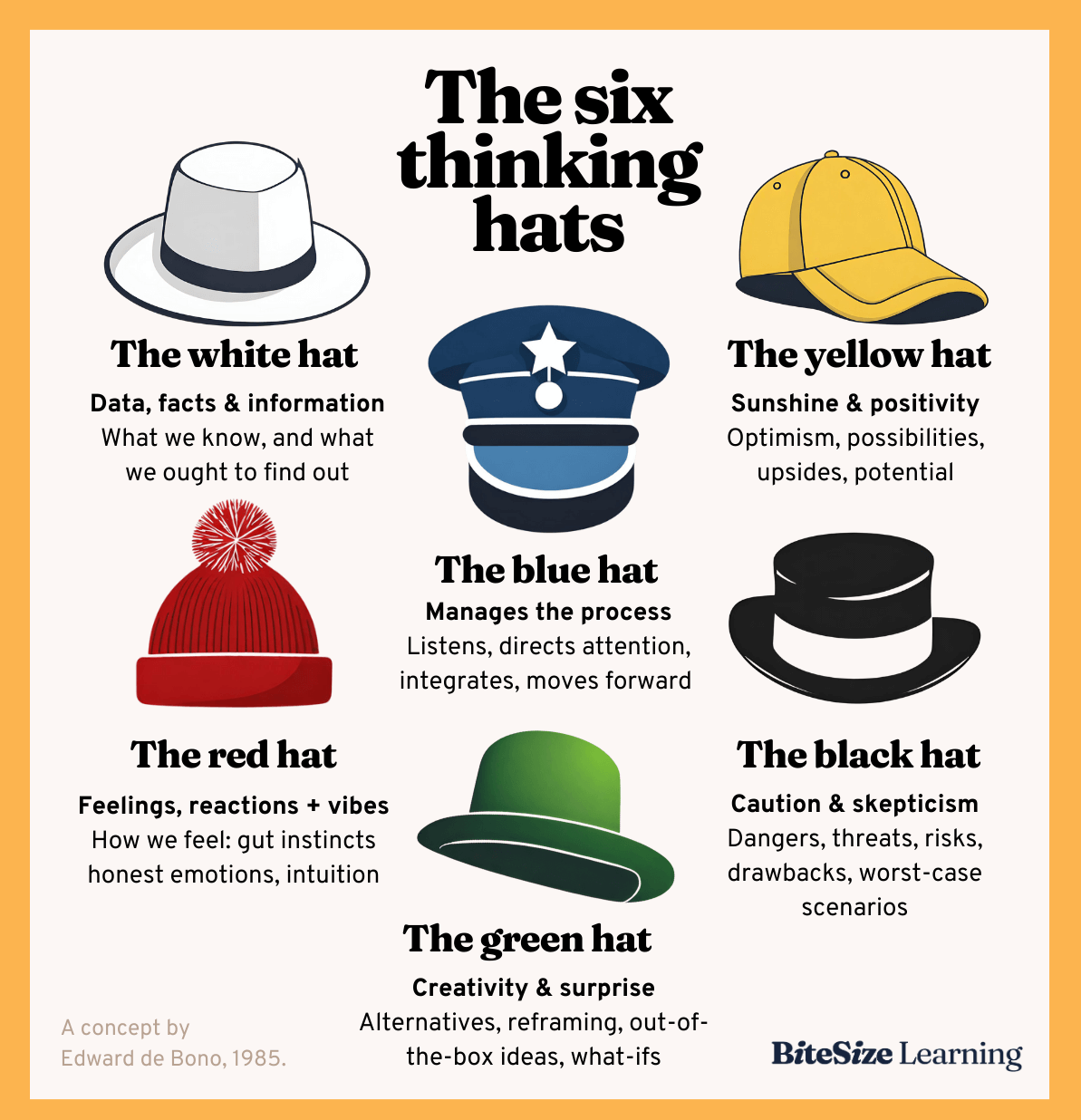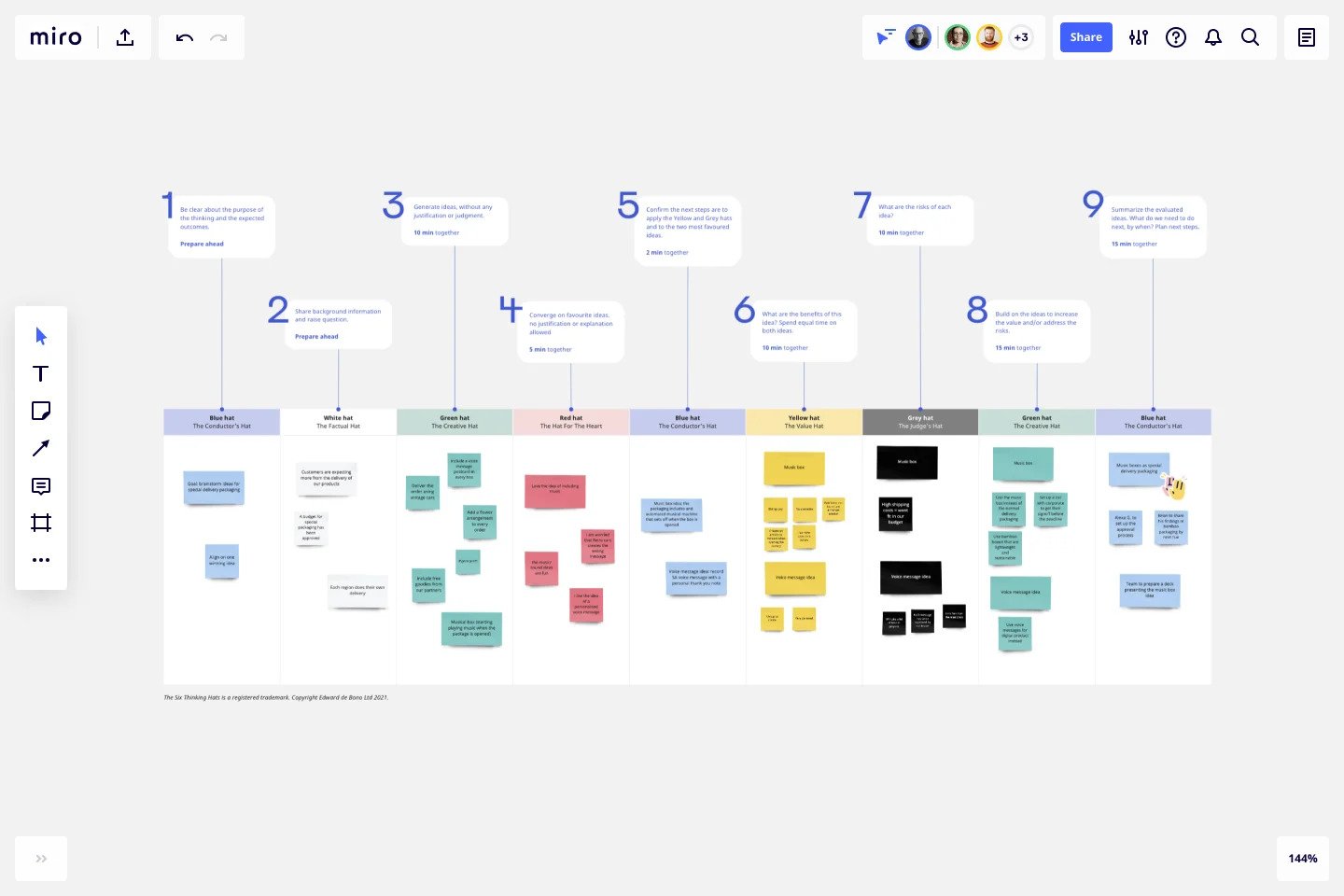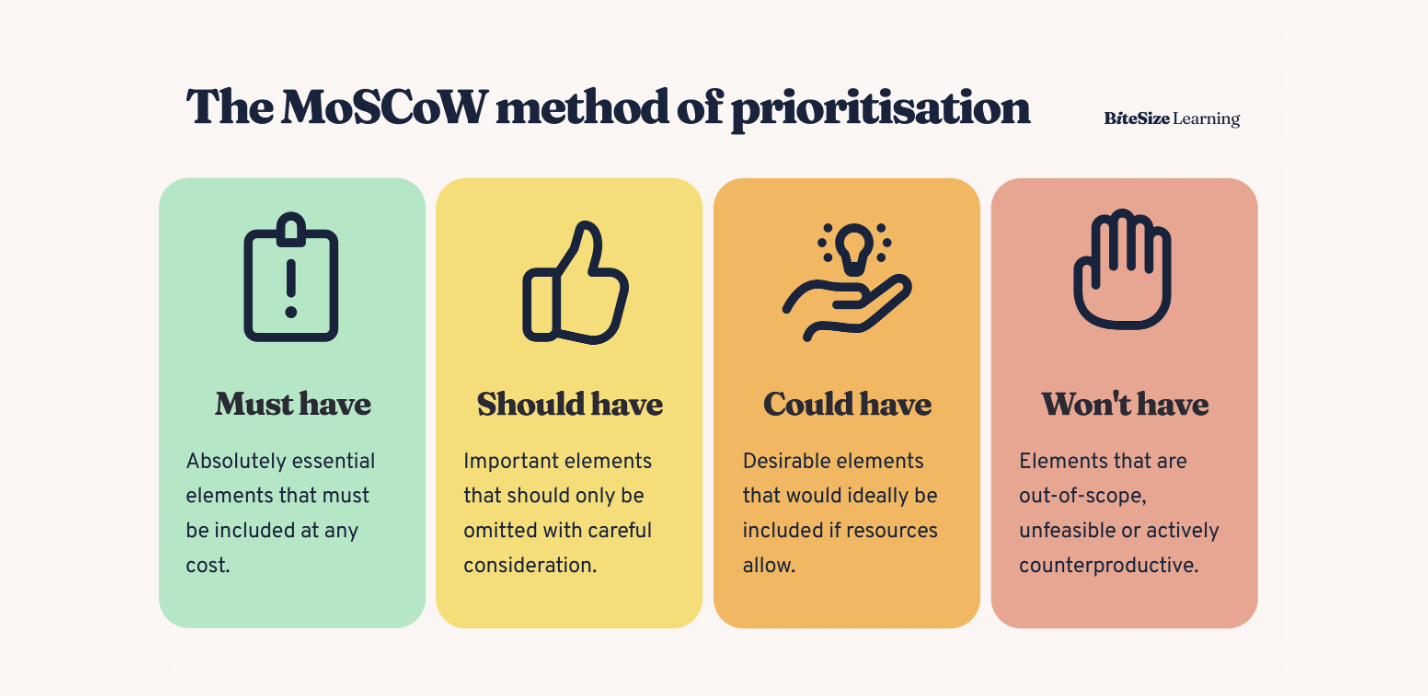Take a look at a problem from all sides with the Six Thinking Hats technique
The Six Thinking Hats technique, explained
The classic Six Thinking Hats technique, conceived by Edward de Bono in 1985, is a valuable tool for brainstorming, creative problem solving and making decisions.
Essentially, it’s a meeting structure which calls for devoting specific blocks of time to six different thinking styles: for example, dispassionate analysis of the facts, an examination of potential risks, an airing of participants’ emotional responses and ‘gut responses’, or an exploration of creative ideas.
During each section (named after a different colour hat) participants focus on the issue at hand purely from the perspective of that hat. Contributions of a different nature must wait until the relevant hat is in play.
This allows the person running the meeting to manage the overall tenor of the conversation and allow a variety of perspectives to be heard.
The advantages of the Six Thinking Hats technique
Using the Six Thinking Hats offers a number of benefits to the team:
Prevent a single person or perspective taking over. A discouraged team may tend to dwell excessively on the negative; this framework ensures the skeptical mindset does not totally dominate discussion.
Ensure overlooked perspectives are given due time: A group under pressure to solve a difficult crisis might quickly ‘lock in’ to a fact-finding, fire-fighting approach. But by creating appropriate space for other perspectives, new ideas may emerge. For instance, the ‘positive’ yellow hat might seek solutions that don’t merely ‘solve the problem’ but actually leave the organisation better off than they were before.
Prevent people ‘talking past each other’: one personality profile may tend to focus on practicalities, while another may prefer to emphasise the possible upsides of a course of action. In an unstructured conversation, both may anxiously try to bring the discussion around to ‘what really matters’ (their pet perspective!), whereas in this system, they can relax knowing that there’s an allocated time to argue their favoured case.
Creates space for emotional disclosure: understanding how everyone’s feeling about an issue is a good way to take the temperature of the room, overcomes the sense that disclosing these things is unprofessional, and helps people communicate more empathetically with each other. This helps build team trust in the longer term.
The Six Thinking Hats, one-by-one
Let’s take a look at each of the Six Thinking Hats in turn.
The white hat: facts, objectivity and logic
In this mode, you look at the information you have, identify what you don’t have, and consider how you can get additional information.
When the White Hat is in use, participants are encouraged to present existing data, including statistics, reports, and tangible evidence relevant to the topic at hand.
This hat is particularly valuable in establishing a solid foundation of understanding, ensuring that decisions and strategies are built upon verifiable and unbiased information. In essence, the White Hat is not merely about stating facts; it's about developing an informed understanding of the situation. This approach can lay a reliable groundwork for the subsequent hats, ensuring that the strategies and solutions developed are not only creative and innovative but also realistic and feasible.
The red hat: feelings, subjectivity and instinct
The Red Hat's primary value lies in its ability to bring forth the underlying emotional responses that might otherwise go unspoken or be considered irrelevant in more traditional, data-driven discussions.
By explicitly inviting emotional input, the Red Hat ensures that these insights are not only voiced but also respected and considered as part of the holistic understanding of the issue at hand. This process can be particularly enlightening, revealing personal values, concerns, and motivations that might significantly influence the direction and acceptance of decisions.
Another key consideration is the recognition that emotional responses, while not always based on logic or fact, are genuine and can provide invaluable insights into personal and collective morale, apprehension, enthusiasm, and other critical factors that could influence the success or failure of a decision or project.
Important: participants should not need to justify or defend their emotional reactions during this section – there are no wrong answers! Likewise, other attendees need not rush to assuage anxieties or temper enthusiasms. Just let people talk.
The yellow hat: optimism, positivity and possibility
This hat encourages participants to explore the positive aspects of a situation, focusing on opportunities, benefits, and value.
Unlike the cautionary Black Hat, the Yellow Hat is about envisioning the best-case scenarios and the potential rewards that can arise from a particular strategy or decision.
The intrinsic value of the Yellow Hat lies in its ability to counterbalance the natural tendency towards critical or negative thinking that often dominates group discussions. By intentionally seeking out the positives, this hat helps to cultivate a sense of hope and motivation, which can be particularly crucial in driving innovation and creative problem solving. It prompts participants to look beyond immediate obstacles and consider the long-term potential and growth opportunities.
This optimistic viewpoint can be particularly beneficial in situations that initially seem daunting or intractable, as it encourages a 'can-do' attitude and a focus on solutions rather than problems. When using the Yellow Hat, it is important to encourage realistic optimism. While the focus is on the positive, it should not stray into wishful thinking or unfounded assumptions. The optimism should be grounded in plausible outcomes and rational extrapolation of facts.
The black hat: caution, risks and drawbacks
The primary purpose of the black hat to encourage a critical evaluation of ideas, strategies, and proposals, focusing on identifying potential flaws, risks, and obstacles.
This hat is not about pessimism for pessimism's sake; rather, it's a tool for risk assessment and contingency planning, ensuring that decisions are robust, well-thought-out, and sustainable.
Using the Black Hat effectively involves a careful and methodical examination of the downsides of a plan or idea. This includes considering worst-case scenarios, identifying what could go wrong, and assessing the potential consequences of failure. The Black Hat's value lies in its ability to prevent groupthink and overly optimistic decision-making. By deliberately seeking out potential problems, it ensures that plans are not just feasible and desirable but also viable and resilient in the face of challenges.
Use the Black Hat thoughtfully. Overuse can lead to a downbeat atmosphere, stifling creativity and risk-taking. This is a time for critical thinking and dispassionate analysis, not just grumpy “it’ll never work” negativity. Try to draw out constructive steps forward from each critique: how risks might be mitigated, for example, or opposition overcome.
The green hat: creativity, imagination, and lateral thinking
The green hat is specifically designed to foster out-of-the-box thinking, encouraging participants to explore new ideas, alternative solutions, and unconventional approaches.
This hat is the antithesis of the status quo, challenging the norms and pushing boundaries in the pursuit of creative problem solving.
The essence of the Green Hat lies in its ability to cultivate a fertile ground for creativity. When this hat is in play, participants are encouraged to think freely without the constraints of practicality or criticism. It’s a time for brainstorming, where quantity and variety of ideas are more important than immediate feasibility. This could involve suggesting new products, exploring untapped markets, rethinking operational processes, or proposing radical marketing strategies.
To use the Green Hat effectively, it's crucial to create an environment where imagination and innovation are not just allowed but actively encouraged. This means temporarily suspending judgment and criticism (often associated with the Black Hat), and instead, embracing even the most seemingly outlandish ideas. Participants should be reminded that the goal is not to find an immediate solution but to generate as many ideas as possible, some of which may be the seed for viable solutions.
The blue hat: control, process and co-ordination
The Blue Hat serves as the conductor of the thinking process, offering a crucial overarching perspective that ensures structure and focus.
Distinct from the other hats, which are concerned with specific types of thinking, the Blue Hat is about managing the thinking process itself. It's the hat worn by the meeting's facilitator or leader, guiding the discussion, setting the agenda, and ensuring that each of the other hats is effectively utilised in turn.
The primary purpose of the Blue Hat is to maintain a clear focus and direction throughout a discussion or decision-making process. This involves establishing the objectives at the outset, defining the sequence in which the other hats will be used, and keeping the discussion on track. The Blue Hat is responsible for summarizing and synthesizing the inputs from the other hats, drawing conclusions, and planning the next steps. It's about seeing the 'big picture' and ensuring that the process is coherent and productive.
Effectively using the Blue Hat requires strong leadership and facilitation skills. The person in this role needs to be impartial, keeping their own contributions for when they are wearing the other hats. They should be adept at steering conversations, encouraging participation from all members, and balancing the contributions from the different hats to ensure a well-rounded discussion. This might involve, for example, moving from a predominance of Black Hat (critical) thinking to Green Hat (creative) thinking if the discussion becomes overly negative.
An important aspect of the Blue Hat's role is time management. The facilitator must ensure that each hat is given adequate time for discussion but also keep the meeting moving to cover all necessary points within the allocated time frame. They must also be able to adapt the agenda if needed, for instance, spending more time on a particular hat if the situation demands it.
The Blue Hat also plays a vital role in synthesizing the outputs from the meeting, drawing together the various strands of thought into a coherent plan or decision. This involves not just summarizing what was said but also identifying the main themes, conclusions, and action points. The Blue Hat might conclude the meeting with a summary of decisions made, actions to be taken, and responsibilities assigned, ensuring clarity and commitment from the group.
In summary, the Blue Hat is the key to ensuring that the Six Thinking Hats process is more than just a collection of disparate viewpoints. It provides the necessary structure and guidance to transform diverse inputs into clear, actionable outcomes. With effective Blue Hat leadership, teams can navigate complex discussions efficiently, making decisions that are well-considered, balanced, and actionable.
Tips on using the Six Thinking Hats technique effectively
As the facilitator, you have an important role to play in keeping things on track. A few important tips:
Communicate each hat’s purpose clearly: Ensure that all participants are familiar with the function and purpose of each hat. This understanding is crucial for the effective application of the technique.
Keep the process well-structured: Follow a structured approach to the discussion, with a clear sequence for using each hat. This structure helps maintain focus and ensures that all aspects of the issue are considered.
Manage the time effectively: Allocate a specific amount of time for each hat. This prevents overemphasis on one perspective and ensures a balanced approach. You can of course be flexible and let some hats have more time than others. Be suspicious of hats where ‘nobody has anything to say’ or ‘it doesn’t apply to this’ – sit in the silence for a bit and try to draw out something.
Get everyone contributing: Make sure everyone contributes under each hat. This avoids dominance by a few individuals and ensures diverse viewpoints are considered.
Keep people on-topic (or on-hat, as the case ay be): Keep the thinking under each hat separate from the others. Don’t let participants start veering into another hat’s category until you’ve moved on. Remember a head can only wear one hat at a time!
Create a safe environment: Especially for the Red Hat, create an atmosphere where participants feel comfortable expressing their emotions without fear of judgment.
Record and review contributions: Document the key points raised under each hat. These notes are helpful for review and reference after the session. Use the Blue Hat to regularly summarize the discussion, especially when transitioning between hats. This helps in keeping track of the discussion and in maintaining a clear focus.
Use visual aids: Consider using visual symbols, presentation slides, or even actual hats (!) to reinforce the mode of thinking being used.
Use the underlying principles more broadly: the key purpose of the Hats is to align everyone’s thinking style in some important (but otherwise easy-to-neglect) way at the same time, and by communicating this ahead of time, providing a structure that provides reassurance to meeting participants.But you can apply this insight more broadly, not only by using all Six Hats in a formal process. For instance, it might be as simple as saying: “After I’ve shared with you some of the key details on X, I’d really just like to take a few minutes for everyone to openly share their immediate feelings on the matter, before we dig into the work required.” Or perhaps: “After we’ve done our usual analysis of the issue, I want to hold the final twenty minutes for us to really dream up some really different approaches.”
Six Thinking Hats templates
Let’s look at some tools and resources that can help you facilitate the Six Thinking Hats technique.
Miro template for hybrid/remote collaboration
Using the Six Thinking Hats technique needn’t take place in a meeting room. You can use this approach in a hybrid or remote meeting, or even to share thoughts asynchronously in a structured way.
This Miro template is one such way to document the process virtually.
Presentation template for Six Thinking Hats
As a facilitator, you might find it helpful to put the current hat ‘on screen’ to keep everyone focused on the current phase of the process. A simple presentation is embedded below – just go full-screen to share it.
Example Six Thinking Hats meeting agenda
This example meeting agenda takes about 90 minutes. Yours might run longer or shorter!
1. Opening (5 minutes)
Welcome and Introductions
Brief overview of the meeting's objective and the Six Thinking Hats method
2. Setting the Context (10 minutes)
Review of current market position and recent performance data
Highlight key challenges and opportunities
3. Six Thinking Hats Session (60 minutes)
White Hat (10 minutes)
Focus on available data: Market trends, customer demographics, competitor analysis
Identify gaps in our knowledge and what additional information is needed
Red Hat (10 minutes)
Express gut feelings, intuitions, and emotions about our market position
Encourage open sharing without judgment or need for justification
Black Hat (10 minutes)
Critical assessment of barriers, risks, and potential problems in increasing market share
Discussion of worst-case scenarios and mitigation strategies
Yellow Hat (10 minutes)
Optimistic viewpoints: potential benefits, best-case scenarios, and opportunities
Exploration of what could go right and potential rewards
Green Hat (10 minutes)
Creative brainstorming: new ideas, innovative strategies, and alternative approaches
Encourage out-of-the-box thinking and challenge existing assumptions
Blue Hat (10 minutes)
Process control: summarize insights from each hat
Outline next steps and how to integrate the diverse perspectives into a cohesive strategy
4. Developing an Action Plan (15 minutes)
Define key action items, responsibilities, and timelines
Establish metrics for measuring success and progress
5. Wrap-Up and Closing (5 minutes)
Recap of the decisions and action items
Schedule follow-up meetings or checkpoints
Thank attendees for their participation and contributions
6. Adjournment
Example Six Thinking Hats notes grid
As a facilitator and primary controller of the Blue Hat, taking effective notes is vital for leaving the room with some substantial contributions to process. One easy framework for recording discussions is to make notes in a grid (an Excel workbook will do!) broken out by contributor and Hat. Here’s an example…
| Participant | White Hat (Information) | Red Hat (Emotions) | Black Hat (Cautions) | Yellow Hat (Benefits) | Green Hat (Creativity) | Blue Hat (Process) |
|---|---|---|---|---|---|---|
| Alex | "Our market research shows a 20% increase in demand for exotic fruit flavours among young adults." | "I'm genuinely excited about this new flavour; it feels like a fresh direction for our brand." | "We must consider the cost of sourcing new ingredients. It could increase production costs significantly." | "This could potentially open up a new market segment, appealing to health-conscious consumers." | "What if we launch a limited-edition summer pack with a combination of exotic flavours?" | "Let's focus on aligning our ideas with the market research data and brand vision." |
| Bara | "Competitor analysis indicates no similar flavours in our direct competition's range." | "Honestly, I’m a bit anxious about how our long-term customers will react to such a bold flavour." | "The flavour might be too niche, possibly alienating our core customer base." | "If successful, this could position us as industry innovators." | "How about a cross-promotion with a popular music festival to target the younger demographic?" | "We need to structure our marketing approach to address both new and existing customers." |
| Colin | "Feedback from initial taste tests indicates a 70% approval rating, higher than our last two product launches." | "I'm worried we're moving too fast without enough product testing." | "We need to be wary of overestimating demand and ending up with excess inventory." | "This new flavour could enhance our brand's image as a trendsetter." | "Maybe we could involve social media influencers in a viral 'mystery flavour challenge' campaign." | "Let's summarize our action points and assign specific tasks with deadlines." |
| Diane | "Our social media analysis shows a growing trend in exotic beverage flavours among our target demographic." | "I'm thrilled about the innovative aspect; it aligns with our brand’s creative image." | "There's a risk in flavour fatigue; customers might get bored quickly if it's too unconventional." | "This could be a great opportunity to refresh our brand image and attract media attention." | "We could create an interactive online campaign where customers suggest and vote for their favourite combinations." | "I propose we review the feasibility of these ideas in relation to our budget and timeline constraints." |














